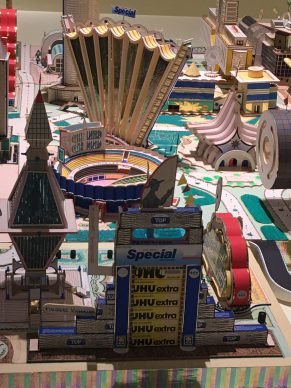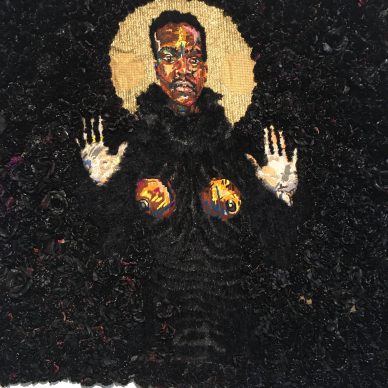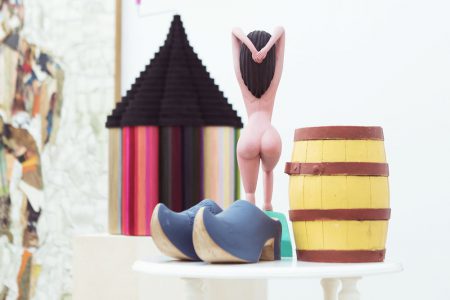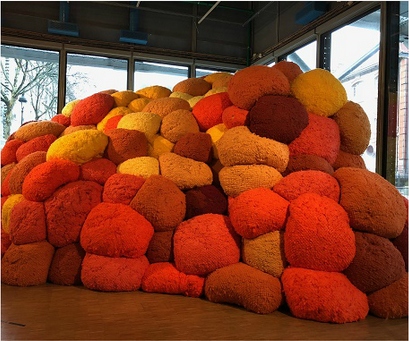That’s Africa, a jigsaw of identities.
Art critics, however, still have a tendency to use the catchall term ‘African art’. As if there was such thing as European art…
The Louis Vuitton Foundation in Paris has opted, to its credit, to highlight the diversity.
As the artistic director Suzanne Pagé underlines, ‘It’s a journey through time and space.’
The show, through 45 artists, is rich, abundant, saturated with colours, as well as black-and-white.
It stretches from the 1980s to 2016, from a festive and exuberant Congo to a South Africa crippled by the aftereffects of apartheid.
There’s an entire floor of artworks from the gigantic collection (10,000 pieces) of eccentric businessman Jean Pigozzi, who mounted them with the help of specialist André Magnin.
Pigozzi, a hypochondriac who has never set foot in Africa, has principally devoted himself to sub-Saharan artists. He speaks about his collection:
The barrel masks by Romuald Hazoume (born 1962) have been elegantly hung next to 38 celebrity mini-portraits by Ivoirian sage Frederic Bruly Bouabré (1923-2014) drawn on the back of shampoo bottles labels.
The miniature cities by Congolese artist Bodys Isek Kingelez (1948-2015), meanwhile, are made of toothpaste packaging and sweet wrappers. Recycling is raised to high art.
Romuald Hazoume explains the meaning of his masks:
South Africa is the strong card in this large show, commanding an entire floor as well as a part of the foundation’s collections. This country’s open wounds – violence, poverty, corruption, racism – provide the artists with a remarkable power.
The country’s most famous artist is William Kentridge (born 1955), a successor to Dada and Méliès, who blends the serious and the burlesque in large, hypnotic video installations that resemble carnival processions set to syncopated rhythms.
He’s designing the set for an opera in Salzburg this summer, but found the time to talk from his studio in Johannesburg about his eclectic background, including his time at a school of mime in Paris.
David Goldblatt (born 1930), who will have a retrospective at the Pompidou Centre next year, is committed to capturing the evolution of behaviours in his country with annotated photos like in 2015 in Cape Town when during student protests a dethroned statue was the object of a strange public communion: people raised their arms to the sky not to express their support for a political cause but to take photos with their telephones.
He explained the political context behind his photos:
In South African art, dogs are ubiquitous. As both symbols of repression and unhappy lives, these skinny roaming beasts haunt the sombre expressionist paintings of former anti-apartheid activist David Koloane (born 1938). He explains why dogs play an important role in his pictorial universe.
One of the most spectacular works in the exhibition are the tapestries by Athi-Patra Ruga (born 1984).
Claiming to be a signed-up member of the selfie generation, he’s produced countless self-portraits on large multi-coloured tapestries.
He weaves them himself. ‘I love the discipline that weaving gives me. It’s an activity that’s both docile and feminine, and which I add my own personality to.’
Athi-Patra Ruga identifies himself as black, gay and non-Christian and puts himself in lyrical scenes that deal with heroes and violence.
The raw material for Buhlebezwe Siwani’s work is a dirt-cheap green soap used in the poorest neighbourhoods to do the washing up and to scrub down children.
The artist, who practices as a healer as well, confides how the detergent symbolises a childhood trauma when her grandmother washed her at the water tap in her township, naked, in front of everyone.
She reflects on how local traditions are being lost with the advance of Christianity.
Finally Musa Nxumalo, commissioner of the South African pavilion at the forthcoming Venice Biennale and curator of the Johannesburg Art Gallery, explains the burden of history weighing on the South African scene today:
The world of South African art offers precious keys for understanding the dramatic current events affecting the country.
Until 28 August. www.fondationlouisvuitton.fr
Also in Paris at La Villette the Festival 100% Afrique and the exhibition Metropolis Afrique capitales until 28 May: https://lavillette.com/en/evenement/festival-100-2017
Support independent news on art.
Your contribution : Make a monthly commitment to support JB Reports or a one off contribution as and when you feel like it. Choose the option that suits you best.
Need to cancel a recurring donation? Please go here.
The donation is considered to be a subscription for a fee set by the donor and for a duration also set by the donor.
















